
Marycrest College Historic District is located on a bluff overlooking the West End of Davenport, Iowa, United States. The district encompasses the campus of Marycrest College, which was a small, private collegiate institution. The school became Teikyo Marycrest University and finally Marycrest International University after affiliating with a private educational consortium during the 1990s. The school closed in 2002 because of financial shortcomings. The campus has been listed on the Davenport Register of Historic Properties and on the National Register of Historic Places since 2004. At the time of its nomination, the historic district consisted of 13 resources, including six contributing buildings and five non-contributing buildings. Two of the buildings were already individually listed on the National Register.
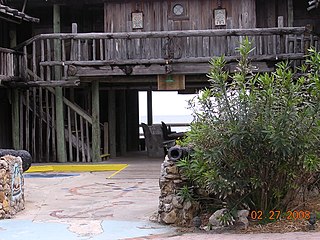
The Driftwood Inn and Restaurant is a historic site in Vero Beach, Florida. It is located at 3150 Ocean Drive. On August 6, 1994, it was added to the U.S. National Register of Historic Places. The Driftwood Inn was opened in 1937, conceived and constructed by local Vero Beach eccentric and businessman Waldo E. Sexton. The hotel and resort were continually expanded throughout the years, and the property is now a partial interval ownership/timeshare along with being a traditional hotel.
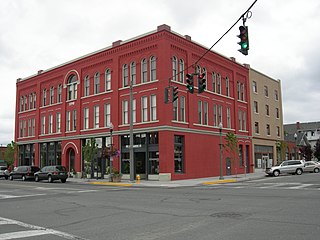
The Wilson Hotel is a historic building in downtown Anacortes, Washington, United States. It was built in 1890 during a speculative land boom when cites across northern Puget Sound were competing to become the western terminus of the Great Northern Railway's transcontinental route. It was designed by Pickles and Sutton and built by David Wilson, all of Tacoma, and was built of locally made brick. The building's design is Romanesque with masticated stone bases, rounded windows and roman arches. Rechristened the New Wilson Hotel after a remodeling in 1911, The hotel was expanded in 1926 with a 4-story addition that matched the height of the original 3-story building. It served as a hotel into the 1970s when it was converted to apartments. Recently, the Wilson underwent complete restoration and earthquake retrofitting. The work was completed in 2007. The Wilson currently features retail on the main floor and low income housing on the upper floors.

The Davenport Hotel is a historic building located in downtown Davenport, Iowa, United States. It was individually listed on the National Register of Historic Places in 1983. In 2020 it was included as a contributing property in the Davenport Downtown Commercial Historic District. It is currently an apartment building called The Davenport.
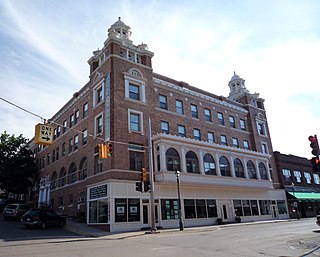
The Douglass House is a hotel located at the corner of Shelden Avenue and Isle Royale Street in Houghton, Michigan. It was placed on the National Register of Historic Places in 1982.
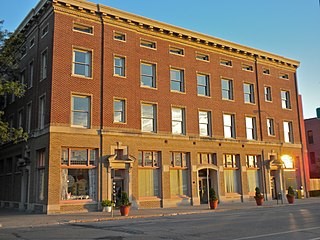
The Northwestern Hotel is an historic building located in the East Village of Des Moines, Iowa, United States. It was listed on the National Register of Historic Places in 1984.

City Hotel, also known as Seifert's Tavern and the Wheatland Feed Mill, on 214 South Main Street in Wheatland, Iowa was listed on the National Register of Historic Places for Clinton County, Iowa in 2007.

The Lincoln Hotel is a historic building located in Lowden, Iowa, United States. It was listed on the National Register of Historic Places in 1996. The Lincoln Highway was established in 1913 and passed through Lowden. This hotel was built in 1915 to accommodate the travelers that passed through town. Celia Clemmens, who operated the railroad hotel in town, and her husband A.F. Clemmens built and operated this hotel as well. The hotel is a two-story, rectangular structure with an exterior covered with pebble dash stucco. The shallow-pitched hip roof, wide eaves and the stucco finish reflect the influence of the Prairie School, while the Tuscan columns on the porch and crown window moldings reflect the Neoclassical style. Off the front porch the first floor housed a small lobby, guest parlor and dining room, and the owner's living quarters. The second floor housed the twelve guest rooms and two bathrooms. A first floor addition built in 1920 to increase the size of the owner's quarters has subsequently been removed. The Lincoln Highway in Iowa became U.S. Route 30 in the 1920s, and it was realigned in the mid-1950s just to the south of Lowden. The hotel was able to stay in business until 1981. The building sat empty for the next twelve years before it was converted into apartments from 1994 to 1995.
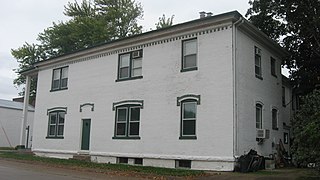
The Hotel Wapello is a historic building located in Wapello, Iowa, United States. It was listed on the National Register of Historic Places in 2001 as Commercial Hotel.

The Burlington, Cedar Rapids & Northern Freight House, also known as the Rock Island Freight House, is a historic building located in Burlington, Iowa, United States. It was listed on the National Register of Historic Places in 1983.

Bedford House, also known as the Garland Hotel, is a historic building located in Bedford, Iowa, United States. It was built in three stages. The first section was completed in 1857. Additions were completed in 1877 and 1910. Charles Steele, a local businessman, farmer, and banker, had the structure built and was its first owner. The original hotel was used as a stage coach depot until the railroad came to Bedford in 1872. It suffered some damage in a fire that destroyed five other commercial buildings in 1877. Until 1880 the building also housed a jail in the cement fruit cellar. The hotel was renamed the Hotel Garland by its new owner John Clark in 1906. The building was listed on the National Register of Historic Places in 1977. The hotel closed in 1997 after it served an estimated 150,000 guests. The building started to fall into disrepair. The 1910 addition collapsed in 2004, which almost led to the building being torn down. Instead it led to a community effort to save the building.

The Iowan's Hotel, now known as the Railroad Inn, is a historic building located in Essex, Iowa, United States. The town of Essex was established by the Burlington and Missouri River Railroad. It was platted in 1870 as a station along the line. The depot opened in 1871 and the Lindel Hotel was completed in 1878. This building was completed in 1906 to replace the outdated Lindel. It operated under a variety of names over the years, including the Essex Hotel, Rose Hotel, Commercial Hotel, Bradley Hotel, Butler Hotel, Essex House, and the Railroad Inn. It is operated as a bed and breakfast under the last name. The building was listed on the National Register of Historic Places in 2009.
Aunty Green Hotel is a historic building located in Bonaparte, Iowa, United States. The hotel was built by John Green in 1844. His wife Mary continued to operate the hotel for many years after his death, and that what gave the business its name. It was the second hotel established in town, and it is believed to be the first brick building constructed in Bonaparte. Other businesses that have been housed in this building include a photography studio, doctor's offices, the first local telephone exchange, a creamery and a gas station. The Van Buren County Historical Association rescued the structure from demolition. It is currently owned by the Bonaparte Historical Society and houses the Auntie Green Museum and the public library.

The Herring Hotel, also known as the Herring Cottage, The Herring, Hotel Herring, The Graham House Hotel, is a historic building located in Belle Plaine, Iowa, United States. Built in 1900, the American Craftsman style frame building replaced an earlier hotel with the same name that had been destroyed in a massive fire that destroyed most of the central business district in 1894. Will Herring built his namesake hotel and he had owned the previous hotel, which had been built by his father-in-law William Blossom as the Tremont House. The building was designed by Cedar Rapids architect Charles A. Dieman, and constructed by local contractor James Park.

The Chicago, Rock Island and Pacific Railroad: Stuart Passenger Station is a historic building located in Stuart, Iowa, United States. The town of Stuart was laid out by Charles A. Stuart, for whom it is named, in concert with the Chicago, Rock Island and Pacific Railroad. The railroad reached this point in 1868 and the depot was completed the following year. It is a single story, side gable, frame structure covered with brick veneer. The segmentally-arched widows are capped with brick hoods and limestone keystones. It contains four rooms that housed a baggage room, men's waiting room, ticket office, and the ladies waiting room. This was one of several buildings constructed in Stuart by the Rock Island Line, which placed a divisional headquarters here from the beginning. Other facilities included a roundhouse (1871) and brick shops (1874) that replaced wood-frame structures. In 1897 the railroad moved its facilities to Valley Junction, now West Des Moines.

The American House, also known as the American Hotel, Evans Hotel, and Ryan House, is a historic building located in McGregor, Iowa, United States. Ohio native William H. Harding had the three-story structure built in 1854. It is a stone building that is covered with a brick veneer on the upper two floors. McGregor was a river port that immigrants used to get to western Iowa, southern Minnesota and points west. In the early years most people came to town via ferry or packet boats on the Mississippi River. They would leave by horse, stagecoach, wagon or train. The stagecoach departed from in front of the hotel. The ticket office for the railroad, which was located across Main Street, was established in the hotel lobby. An addition was constructed on the southwest side of the original building. The sunrooms were built above it in the 1970s and 1980s. The building was individually listed on the National Register of Historic Places in 2001. In 2002 it was listed as a contributing property in the McGregor Commercial Historic District.

Hotel Lester-Lester Cafe, also known as the Dodge House-Long Branch, is a historic building located in Mason City, Iowa, United States. Its construction, completed in 1915, was a project undertaken by local real estate developer Meir Wolf. It was built as a two-story building a block away from the passenger and freight depots of the Chicago and North Western Railroad and the Chicago Great Western Railway. The building was meant to be used as a railroad hotel so passengers and rail employees would not have to travel the six to eight blocks to the hotels downtown. It is the only remaining railroad hotel left in Mason City. Hotel guests stayed in the 29 rooms on the second floor, and three commercial spaces on the first floor were occupied by a variety of restaurants, grocery stores and barbershops. Its most famous guest was track star Jesse Owens, who was in town in December 1937 for a basketball exhibition. He could not stay at the other hotel's in town because of his race. In 1975 the hotel's name was changed to the Dodge House and the Long Branch Saloon occupied the space that had previously housed a cafe. By that time it was largely used as a rooming house, and it was used to house the homeless. The building was listed on the National Register of Historic Places in 2002.

Iowa Beta Chapter of Sigma Phi Epsilon is a historic building in Ames, Iowa, United States. It is a large four-story brick structure that was built in 1931 for the Sigma Phi Epsilon fraternity at Iowa State College. It was designed by Des Moines architect Amos B. Emery. It is the only Tudor Revival style building designed by Emory, and only one of two fraternity houses that he designed. The building features ornamental half-timbering and stucco veneered walls, a steeply pitched roof with two separate cross-gabled sections, and a two-story wing that is oriented diagonally from the main body of the house. Three of the four-floors are above grade and one is exposed on the back side via the sloping lot.

The Marshfield Central Avenue Historic District is part of the old downtown of Marshfield, Wisconsin. The original wooden downtown burned in a huge fire in 1887. Some of the brick buildings built immediately after the fire still stand - especially near the railroad. Other buildings were added later, and the district includes some off Central, like the old city hall and the depot.

The Vermont House and Fenton Grain Elevator are two adjacent buildings located at 302 and 234 North Leroy Street in Fenton, Michigan. They were listed on the National Register of Historic Places in 1980.





















